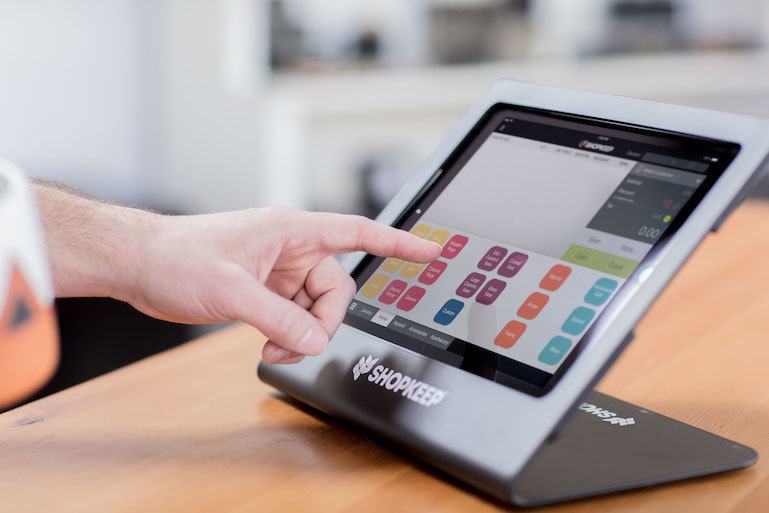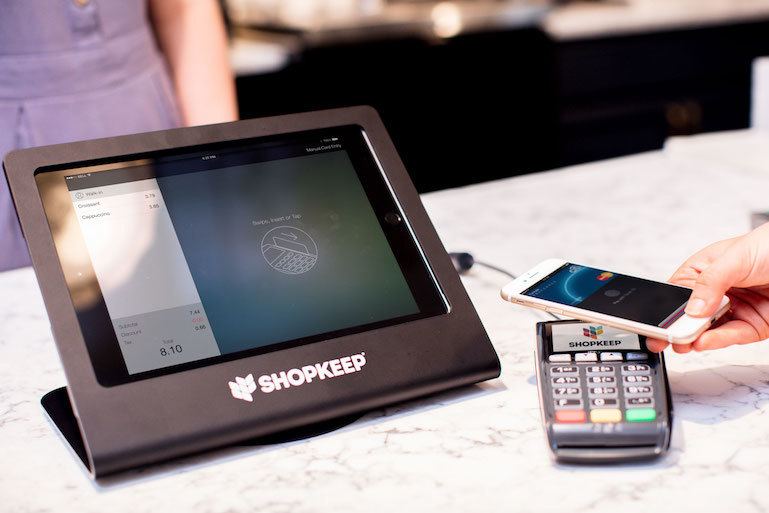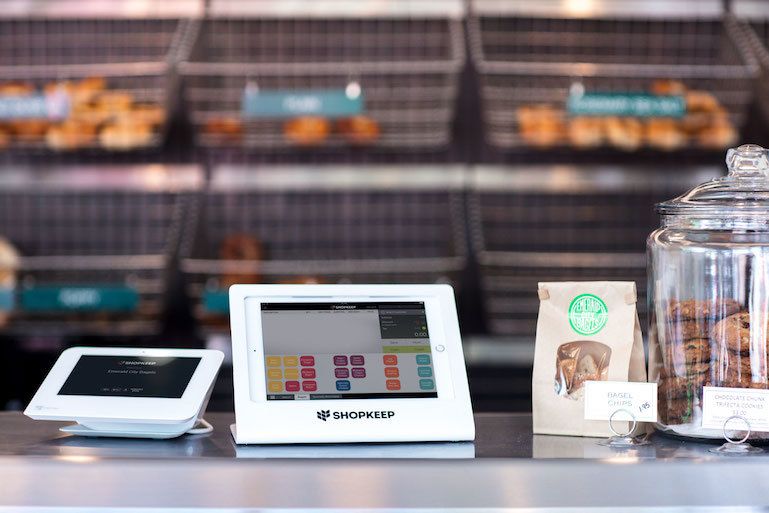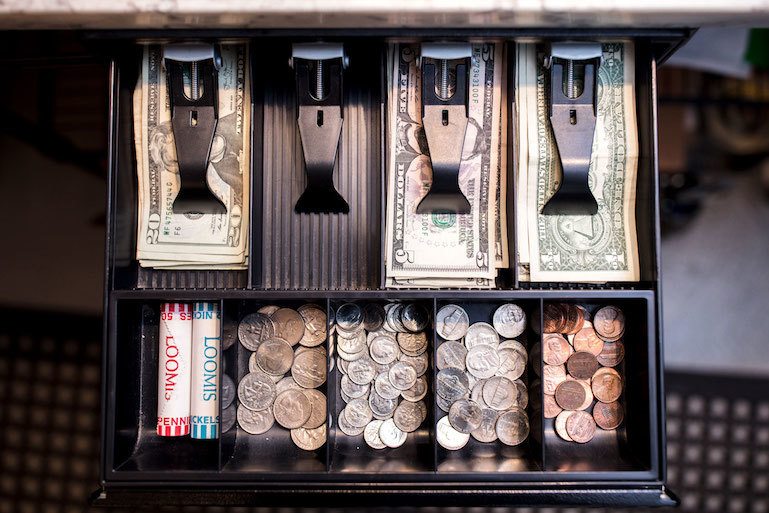
What is a POS System? Your Guide to All Types of POS Systems
What is a POS system? If you’re a small business owner, chances are you’ve heard of a point of sale (POS) system.
However, just because you’ve heard of something, doesn’t necessarily mean you know everything there is to know about it – especially if your source is less than reliable or you’re a first-time business owner.
Since we’re experts on POS systems here at ShopKeep, and even rated the #1 iPad POS system by merchants like you, we’d like to do you a solid and help you learn everything there is to know about point of sale systems. They’re such a critical part of your business operations, whether you own a small retail shop or a five-star restaurant; POS systems not only get you through your day-to-day operations but also help propel you into the future.
Simply put, POS systems are a combination of software and hardware built to streamline business operations at the point of purchase (POP). They’re quickly replacing cash registers because they can do more than take payments. To help you see what we mean, let’s take a closer look at point of sale systems. Consider this your buyer’s guide. We’ll cover what exactly they are, why you need one, and where you can buy one.
What is POS Software?
Point of sale software is a cash register, but smarter. It’s the focal point of your checkout, allowing you to ring up sales, process returns, and tally your daily revenue – just like a cash register. But, that’s where the similarities end. POS software does more, much more.
When it comes to a POS system, the software is the driving force behind providing you with the right functionality and features to run your business. If we were talking in terms of vehicles, the software would be the engine. Without a working engine to make the car go and power all the other parts, you just have a useless heap of metal – aka POS hardware, but more on that next.
POS software has changed significantly over the last 10-15 years from something that was only available as an on-premise solution for large enterprises with a dedicated IT staff and deep pockets. Nowadays, you have cloud-based solutions that operate on mobile devices like Android tablets and iPad cash registers. You also have a host of POS systems that are pretty much plug-and-play right out of the box or download. For retailers and other small businesses like restaurants, it doesn’t get much better than that.
SEE ALSO: Small Business Basics: What is POS Software?
POS Software for My Business: What to Look For?
When it comes to choosing the right POS software for your small business, you don’t have to buy the most expensive one or the most popular one, you just have to buy the one that works best for your unique business. All businesses are going to operate a little differently than the next, even within the same industry. Therefore, what might work for your restaurant or retail shop won’t work for the restaurant or store down the street.
We LOVE our new ShopKeep POS system! After 9 years with an ok but antiquated POS system, we researched everything (literally) that is out there – for several weeks (months) to find a system that would meet our list of 22 requirements (somewhat quirky needs for a unique business model). ShopKeep was the only one that fulfilled virtually every requirement! – Carole, In-Tea
Here are some general features you’ll want to look for when vetting POS software solutions. We’ll talk about some of the more industry-specific features later, so stay tuned.
Inventory Management
One of the fundamental functions of POS software is to manage inventory for retailers. In fact, a lot of POS software started out as merely that – inventory management software.
In today’s fast-paced, world where customers will just as soon buy an item online if they can’t find it in your store, it’s crucial that you have real-time inventory tracking and inventory control. Too little inventory can result in missed sales and revenue. Too much inventory can result in suppressed cash flow.
Employee Management
Keeping track of your employees can be a business in itself. Who can only work evenings? Who only works days? What are my labor costs so far this week? Can I put another person on the schedule this weekend? It’s like a game of Who’s On First, retail edition. It’s enough to make your head spin.
Luckily for you, many point of sale systems can help alleviate those headaches. You can create employee profiles to store their contact information and their credentials to access the POS system.
SEE ALSO: Point of Sale Definitions: The Lingo You Need to Know
Reporting and Analytics
If your POS software can give you a variety of reports, great. If it can provide you with the right reports, even better. Reports and analytics can provide insights and help you track Key Performance Indicators (KPI) about your business, allowing you to make smarter, data-driven decisions. Ensure that your system offers a variety of reports that can help you better understand the three major aspects of your business: sales performance, employee performance, and inventory management.
Here’s a detailed list of the reports and metrics you’re POS system should be able to offer you:
- Sales by item
- Sales by employee
- Shift reports
- Sales by department and category
- Sales by customer
- Sales by discount
- Sales by payment type (cash, credit or debit card, gift card, or EBT)
- Inventory value
- Product reorder reports
- Cash drawer activity such as pay-ins and payouts
Customer Management and Loyalty Programs
Most POS software will have either a customer database, customer relationship management function (CRM), a customer loyalty program, or all of the above. Engaging with your customers either through email marketing or loyalty programs is an effective weapon to get customers back into your shop – don’t be afraid to use it.
In fact, 58 percent of customers are comfortable with retailers using their purchase history to customize a future shopping experience. The key is, finding the right customers (audience) and sending the right message.
Integrations
While POS software is certainly the hub of your retail business, it’s usually not the only thing working behind the scenes to ensure a smooth operation. Many point of sale systems integrate with third-party software for email marketing solutions, ecommerce platforms for selling online, and accounting software for bookkeeping.

Payment Processing
POS software should be able to handle all of your payment types or tenders, not just some of them. The most common tender types include cash, credit cards, and debit cards, gift cards, checks, coupons, EBT payments, as well as NFC payments and mobile payments like Apple Pay and Samsung Pay. You’ll also want to ensure you’re able to accept both EMV (chip and pin) and magnetic stripe credit card transactions. We aren’t saying you need to accept every tender type, but your POS system should offer you the option to so you have the most flexibility.
If a point of sale system has integrated payment processing, not only will you be able to accept all types, but you’ll be able to see the breakdown of the tenders and accurate records on ones that are reported on as liabilities such as gift cards. For example, with ShopKeep, you can use our in-house payment processing, ShopKeep Payments, or use your preferred credit card processing provider. Both methods are integrated into our robust platform.
Another thing to consider with integrated processing is the rate you’ll pay per transaction. For most businesses, we recommend avoiding flat rate processing. You can often save money by choosing a processor that offers you interchange-plus rates.
Mobility
Whether you’re a food truck and your whole operation is mobile, or you own a retail store with a traditional brick and mortar storefront, it’s always a good idea to think mobile when it comes to your point of sale system. In fact, in 2018 mobile POS (mPOS) is forecasted to surpass standard POS terminals.
Any retailer can attest that regardless of how much square footage you have, there is never enough space. Retailers in metropolises such as New York City where space is at a premium and a minimum, know these pains all too well.
A mPOS solution like an iPad cash register, or one that runs on Android devices, not only gives you a smaller footprint at your checkout area, but it also gives you the opportunity to take the checkout to your customers on the floor. The industry term for the latter is line busting, and it’s an excellent tactic that savvy retailers use to provide a faster, more efficient checkout process and a positive customer service experience.
POS Hardware
Now that you have a good handle on what POS software is and the features you need for your business, let’s talk about the hardware.
Going back to our vehicle analogy where the software is like the engine, this means the hardware is the shiny hunk of metal on the exterior. When technology companies develop software, they enable specific pieces of equipment to work with it. Some of the hardware components that are likely to be compatible with your POS software are:
- iPad or Android tablets and enclosures
- A touchscreen or monitor to function as the pos terminal and display
- Barcode scanners
- Receipt printers
- Cash drawers
- Label printers
- Credit card terminal
- Scale for weighted items
Depending on the nature of your business, you may or may not need all of these components, but this gives you a great starting point.
Types of POS Systems: What Are My Options?
Speaking of the nature of your business, the type of business you operate will determine the right POS system for your needs. Up until this point, we’ve spoken in general terms that any storefront, whether restaurant or retail, needs a point of sale solution. And while this is all true, not all POS systems are created equal – nor is one solution designed to serve all industries. There are many different types of POS systems out there; the trick is finding the right one for your business.
Retail POS Systems
Retail businesses have a unique set of needs and requirements that differ from the requirements of restaurants and vice versa. While in some cases you might be able to use a retail POS system in quick-service restaurants (QSR), it won’t suffice in a full-service restaurant or bar.
Some unique retail POS requirements are:
- Label printing for items without UPC codes
- Employee commissions
- Product matrix and item variants to support different products sizes, colors, etc.
- Scales for weighted items
- Ecommerce integration to set up an online store
Restaurant POS Systems
Just like retailers, restaurateurs have their own set of unique needs when it comes to a POS system. How many fine-dining restaurants do you know that scan a UPC code on your filet mignon before they serve it to you? Precisely, none. Restaurant and bar POS systems don’t need a barcode scanner or label printer. However, here are some of the features they do need:
- Remote ticket printing to send orders from the restaurant POS to a kitchen printer or bar printer
- A custom table map to easily start checks and see what tables are occupied
- A way to keep numerous checks open simultaneously
- A way to split open checks, merge or transfer them
- A receipt printer for getting a physical check to the customer
- The ability to assign order types such as dine-in or takeout
- Online ordering so customers can order from their smartphone or computer
Salon POS Systems
Last but not least, if you own a salon or spa and you’re trying to use a retail or restaurant POS system, you’re not doing yourself any favors. Although, like retail POS systems in QSR establishments, you might be able to use a retail POS solution in some capacity in your salon, it’s not going to be your best fit. Like the other two industries we discussed, salons have their own particular needs such as:
- Online Booking – While walk-ins are welcome at most salons, the majority of customers make appointments to ensure they get the service they want at a time that’s convenient for them. Modern salons and spas use online appointment setting software so customers can easily book appointments without ringing the receptionist.
- Calendar Management – Going hand-in-hand with appointment setting, salons also need a way to manage their employees’ calendars, so they know who is booked and when.
- Memberships – Some spas charge membership fees for premium or specialty services, and they need a way to track all that. A way to securely store customer credit card data, process recurring transactions on a regular basis and have a card expiration report so they can proactively reach out to those customers whose card is set to expire.

POS System Technology
Outside of industry-specific systems, you’ll also want to look at the technical implementation of the POS systems you’re considering purchasing. In general, three are four major categories of systems. We’ll take a look at the features of each to help you decide which is right for your restaurant, retail shop, salon, or other business.
On-Premise POS Systems
On-premise POS technology is the old way of developing and delivering a POS system to the end user. With this kind of setup, your POS software is installed on a server that’s physically housed within your business. Typically your cashiers and waitstaff will use or interact with the system via a POS terminal that might resemble a desktop computer (typically in retail stores) or large touchscreen monitor (commonly found in restaurants).
While these types of systems are used by thousands of businesses, there are a number of issues with them:
- Expensive – these systems can cost tens of thousands of dollars for a multi-terminal setup.
- Limited Access – You typically need to be in your place of business to access the system to make changes, view reports, or manage the backend.
- Lack of Support – Most on-premise systems don’t come with included customer support. If you run into an issue, you’ll need to buy a separate package of support hours, or pay on a per hour basis.
Cloud-Based POS Systems
Like it has with most categories of software, the cloud has similarly transformed point of sale. With a cloud-based point of sale, you get all of the power and functionality of an on-premise POS (and in many cases, more), along with the ease of use, reliability, and convenience of modern software.
The biggest difference between cloud and on-premise software is how the software is delivered to you. Instead of being installed on a server that you maintain, a cloud POS system is installed in remote data centers that are run by the POS vendor. This eliminates a lot of the technical work of maintaining a POS, allowing you to focus on running your business. Plus, you can rest easy knowing that you’ll have secure and reliable access to one of your most important business tools.
Here are some additional benefits that a cloud POS will bring to your business:
- Available Anywhere – Because the software is hosted in the cloud, you can log in from any internet-connected device.
- Affordability – Almost all cloud POS systems charge a monthly subscription fee. Instead of paying thousands of dollars up front, you can often get started for less than $100 a month.
- Regular Updates – One of the benefits of paying month to month is that you get access to regular updates new features at no additional charge. Compare this to the on-premise model where you need to pay to upgrade to new versions to the software and it’s easy to see why the cloud subscription model is so appealing to businesses.
- Ease of Use – Cloud software is modern software, meaning it’s much easier to use than an on-premise solution that hasn’t been updated in a decade.
- Better Support – Whether it’s a difference in philosophy or something else entirely, one thing is for sure. Cloud POS tend to offer more comprehensive support than their on-premise counterparts. 24/7/365 is the new norm and you should avoid any vendor that doesn’t offer it.
Mobile POS Systems (mPOS)
As a subcategory of cloud POS systems, mPOS also run in the cloud and have all the benefits of modern software. What defines this category of systems is the hardware that they run on, specifically mobile devices. For our purposes, that means an iPad, an Android tablet, and in some cases, a smartphone.
In addition to the benefits found in standard cloud POS software, there are a few that are unique to mPOS systems:
- Greater Mobility – Whether you want to do a limited-run popup shop or simply get away from the counter and onto the sales floor, a mPOS can help you make it happen.
- Highly Reliable Hardware – There’s a reason why Apple products are so popular. They just work, and they often do so for years longer than cheaper hardware. When you use an mPOS that runs on an iPad, you invest in hardware today that will last you for the next 5-7 years.
Self-Service Kiosk
This type of POS is typically designed for specific use cases. For example, if you run a movie theatre, you might have a self-service POS so that customers can buy tickets on their own. Another example is the kiosks you see in McDonald’s and other fast food restaurants for ordering meals. Similarly, many grocery stores and department stores offer self-checkout.
The benefits of using one of these systems are related to cost and efficiency. A self-service kiosk POS can reduce the number of cashiers you need to hire, saving you money. At the same time, adding several kiosks will increase the number of customers you can serve at the same time, reducing wait times and improving efficiency.

How Much Do POS Systems Cost and Where Can I Buy One?
POS systems are no longer a luxury for small businesses, but rather table stakes if you want to stay competitive in the evolving business landscape. While it may be a requirement, the good news is that they no longer carry the luxurious price tag they once did more than a decade ago.
Cloud-based software, the Software-as-a-Service (SaaS) business model, and the development of consumer tablet devices like iPads have created the perfect storm in the point of sale industry. It has allowed software companies to develop robust POS solutions for small business owners and dramatically reduced cost as a barrier to entry to a fraction of what it once was.
Before tablet and cloud-based POS systems, it wasn’t uncommon for POS solutions to cost a few thousand to tens of thousands of dollars to install and maintain. For a small business owner, that’s a small fortune.
Nowadays, if you’re a small retail store, you can pay less than $1,000 to get started with an excellent POS system like ShopKeep, which covers both hardware and software. That’s a big difference in price, and one cash-strapped business owners can get on board with.
Not only have point of sale solutions gone down in price, but they’re also much easier to get your hands on. A lot of POS companies offer a self-service model where you can download the app, set up your store, and order hardware without ever having to talk to someone. And that’s great if you’re a self-service kind of guy or gal.
SEE ALSO: How is ShopKeep Different From Square?
However, in most cases, especially when it comes to such a critical piece of your business operations, you want to be able to pick up the phone and talk to someone. You’re going to have questions outside of what you’re able to figure out on your own. Or maybe you can’t figure it all out on your own, and you need a little guidance to set you on the right path.
When it comes to choosing a POS system, make sure you select a software provider that is there for you 24/7/365 by either chat, email, or phone call. While some POS providers offer this as we do here at ShopKeep, not all companies do.
Another alternative to buying a POS system directly from the software company is to go through a certified reseller. Resellers act as the middleman between the software company and the end user. In some cases, they can offer in-person services (like tech support) that the software company cannot and that makes them an invaluable asset to not only the merchant but also the software company.
Why Should I Invest in a POS System?
Small business owners should invest in point of sale software because it’s just smart business. Running a company is hard. It’s long hours, often meaning weekends and holidays away from your family because those are your busiest days of the week or year.
Are you sick of spending all of your time at your shop, cafe, or restaurant without a break in sight? Don’t you want to make life easier and put more hours back into your week? The major benefits of a POS system are that it can do just that. In fact, businesses that are buying POS software for the first time report that improving efficiency is a top priority.
The Bottom Line
After reading this article, you should have a solid understanding of what is a POS system. But, more importantly, you should know the features and functionality you need from a point of sale to run your business efficiently, where to buy one and how much they cost. If you can walk away from this article in confidence about your POS need, then we’ve done our job.
Want to try ShopKeep for yourself?
Just answer a few easy questions.
Need help finding the right point of sale?
Just complete the form. We’ll call you right back to explain how ShopKeep can work for you.
Hit the ground running.Sprinting, in fact!
Read our free, comprehensive guide, Small Business 101, to learn all you need to know about starting a thriving business.

